#of for example the technology of the 60s
Explore tagged Tumblr posts
Text
Some modern au shenanigans
Character description part 1 here
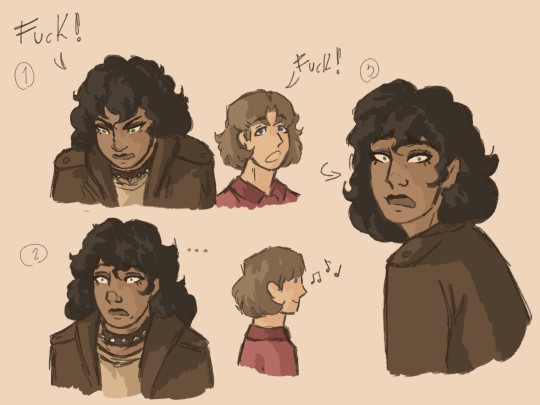
This is the moment Rael knew he is dead meat, little shit won't keep his mouth closed in front of their parents for sure
Rael definitely buys himself makeup with his pocket money (or uses Jo's) and when he and Qui-Gon are alone in the house he just experiements with it
I also totally forgot to do something for halloween night, but happy (late) halloween guys :D
#it's a silly au but i do want to make more modern au content#i just kind of shot myself in the foot#cuz i got so used to the technology of the 80s to early 2000s that i got shocked by my lack of knowledge#of for example the technology of the 60s#like damn technology chill out with this rapid growth#qui gon#qui gon jinn#rael#rael averross#star wars#star wars fanart#star wars art#my art
15 notes
·
View notes
Text
One detail I've always really liked in dunmeshi's worldbuilding is the difference in life expectancies among races. I don't mean the different rates at which they age but specifically how long they live from the point of view of their own group. For example, dwarfs are directly stated to age 2.5x slower than a tall-man, but where tall-men's life expectancy is only about 60, for a dwarf it would be about 200 (equivalent to 80).
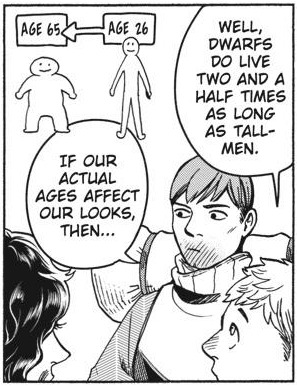
At first this stood out as odd to me but it makes sense when you look up the average lifespan for every race. In general, the short-lived races all have a smaller age of maturity to life expectancy ratio than all the long-lived ones.
I really love this discrepancy because the implication here is that long-lived races not only have longer lifespans due to aging slower, but they also just live longer generally due to a better quality of life, as they have taken the most fertile and livable lands to themselves, resulting in less conflicts over resources and faster technological developments.

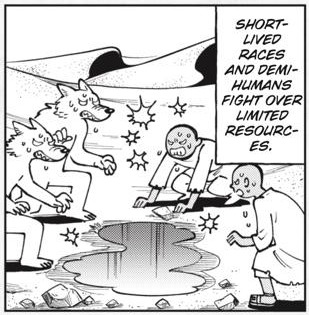
Ultimately how long you live isn't just a fantastical element of the setting, but a political one as well.
9K notes
·
View notes
Text
Ko-fi prompt from @liberwolf:
Could you explain Tariff's , like who pays them and what they do to a country?
Well, I can definitely guess where this question is coming from.
Honestly, I was pretty excited to get this prompt, because it's one I can answer and was part of my studies focus in college. International business was my thing, and the issues of comparative advantage (along with Power Purchasing Parity) were one of the things I liked to explore.
-----------------
At their simplest, tariffs are an import tax. The United States has had tariffs as low as 5%, and at other times as high as 44% on most goods, such as during the Civil War. The purpose of a tariff is in two parts: generating revenue for the government, and protectionism.
Let's first explore how a tariff works. If you want to be confused, then you need to have never taken an economics class, and look at this graph:

(src)
So let's undo that confusion.
The simplest examples are raw or basic materials such as steel, cotton, or wine.
First, without tariffs:
Let us say that Country A and Country B both produce steel, and it is of similar quality, and in both cases cost $100 per unit. Transportation from one country to the other is $50/unit, so you can either buy domestically for $100, or internationally for $150. So you buy domestically.
Now, Country B discovers a new place to mine iron very easily, and so their cost for steel drops to $60/unit due to increased ease of access. Country A can either purchase domestically for $100, or internationally for $110 (incl. shipping), which is much more even. Still, it is more cost-effective to purchase domestically, and so Country A isn't worried.
Transportation technology is improved, dropping the shipping costs to $30/unit. A person from Country A can buy: Domestic: $100 International: $60+$30 = $90 Purchasing steel from Country B is now cheaper than purchasing it from Country A, regardless of where you live.
Citizens in Country A, in order to reduce costs for domestic construction, begin to purchase their steel from Country B. As a result, money flows from Country A to B, and the domestic steel industry in Country A begins to feel the strain as demand dwindles.
In this scenario, with no tariffs, Country A begins to rely on B for their steel, which causes a loss of jobs (steelworkers, miners), loss of infrastructure (closing of mines and factories), and an outflow of funds to another country. As a result, Country A sees itself as losing money to B, while also growing increasingly reliant on their trading partner for the crucial good that is steel. If something happens to drive up the price of B's steel again, like political upheaval or a natural disaster, it will be difficult to quickly ramp up the production of steel in Country A's domestic facilities again.
What if a tariff is introduced early?
Alternately, the dropping of complete costs for purchase of steel from Country B could be counteracted with tariffs. Let's say we do a 25% tariff on that steel. This tariff is placed on the value of the steel, not the end cost, so:
$60 + (0.25 x $60) + $30 = $105/unit
Suddenly, with the implementation of a 25% tariff on steel from Country B, the domestic market is once again competitive. People can still buy from Country B if they would like, but Country A is less worried about the potential impacts to the domestic market.
The above example is done in regards to a mature market that has not yet begun to dwindle. The infrastructure and labor is still present, and is being preemptively protected against possible loss of industry to purchasing abroad.
What happens if the tariff is not implemented until after the market has dwindled?
Let's say that the domestic market was not protected by the tariff until several decades on. Country A's domestic production, in response to increased purchasing from abroad, has dwindled to one third of what it was before the change in pricing incentivized purchase from B. Prices have, for the sake of keeping this example simple, remained at $100(A) and $60(B) in that time. However, transportation has likely become better, so transportation is down to $20, meaning that total cost for steel from B is $80, accelerating the turn from domestic steel to international.
So, what happens if you suddenly implement a tariff on international steel? Shall we say, 40%?
$60 + (0.4 x 60) + 20 = $104
It's more expensive to order from abroad! Wow! Let's purchase domestically instead, because these prices add up!
But the production is only a third of what it used to be, and domestic mines and factories for refining the iron into steel can't keep up. They're scaling, sure, but that takes time. Because demand is suddenly triple of the supply, the cost skyrockets, and so steel in Country A is now $150/unit! The price will hopefully come down eventually, as factories and mines get back in gear, but will the people setting prices let that happen?
So industries that have begun to rely on international steel, which had come to $80/unit prior to the tariff, are facing the sudden impact of a cost increase of at least $25/unit (B with tariff) or the demand-driven price increase of domestic (nearly double the pre-tariff cost of steel from B), which is an increase of at least 30% what they were paying prior to the tariff.
There are possible other aspects here, such as government subsidies to buoy the domestic steel industry until it catches back up, or possibly Country B eating some of the costs so that people still buy from them (selling for $50 instead of $60 to mitigate some of the price hike, and maintain a loyal customer base), but that's not a direct impact of the tariff.
Who pays for tariffs?
Ultimately, this is a tax on a product (as opposed to a tax on profits or capital themselves, which has other effects), which means the majority of the cost is passed on directly to the consume.
As I said, we could see the producers in Country B cut their costs a little bit to maintain a loyal customer base, but depending on their trade relationships with other countries, they are just as likely to stop trading with Country A altogether in order to focus on more profitable markets.
So why do we not put tariffs on everything?
Well... for that, we get into the question of production efficiency, or in this case, comparative advantage.
Let's say we have two small, neighboring countries, C and D, that have negligible transportation costs and similar industries. Both have extensive farmland, and both have a history of growing grapes for wine, and goats for wool. Country C is a little further north than D, so it has more rocky grasses that are good for goats, while D has more fertile plains that are good for growing grapes.
Let's say that they have an equal workforce of 500,000 of people. I'm going to say that 10,000 people working full time for a year is 1 unit of labor. So, Country C and Country D have between the 100 units of labor, and 50 each.
The cost of 1 unit of wool = the cost of 1 unit of wine
Country C, having better land for goats, can produce 4 units of wool for every unit of labor, and 2 units of wine for every unit of labor.
Meanwhile, Country D, having better land for grapes, can produce 2 units of wool per unit of labor, and 4 units of wine per unit of labor.
If they each devote exactly half their workforce to each product, then:
Country C: 100 units of wool, 50 units of wine Country D: 50 units of wool, 100 units of wine
Totaling 150 units of each product.
However, if each devotes all of their workforce to the product they're better at...
Country C: 200 units of wool, no wine Country D: no wool, 200 units of wine
and when they trade with each other, they each end up with 100 units of each product, which is a doubling of what their less-efficient labor would have resulted in!
The real world is obviously much more complicated, but in this example, we can see the pros of outsourcing some of your production to another country to focus on your own specialties.
Extreme examples of this IRL are countries where most of the economy rests on one product, such as middle-eastern petro-states that are now struggling to diversify their economies in order to not get left behind in the transition to green energy, or Taiwan's role as the world's primary producer of semiconductors being its 'silicon shield' against China.
Comparative advantage can be used well, such as our Unnamed Countries (that are definitely not the classic example of England and Portugal, with goats instead of sheep) up in the example. With each economy focusing on its specialty, there is a greater yield of both products, meaning a greater bounty for both countries.
However, should something happen to Country C up there, like an earthquake that kills half the goats, they are suddenly left with barely enough wool to clothe themselves, and nothing for Country D, which now has a surplus of wine and no wool.
So you do have to keep some domestic industry, because Bad Things Can Happen. And if we want to avoid the steel example of a collapse in the given industry, tariffs might be needed.
Are export tariffs a thing?
Yes, but they are much rarer, and can largely be defined as "oh my god, everyone please stop getting rid of this really important resource by selling it to foreigners for a big buck, we are depleting this crucial resource."
So what's the big confusion right now?
Donald Trump has, on a number of occasions, talked about 'making China pay' tariffs on the goods they import into the US. This has led to a belief that is not entirely unreasonable, that China would be the side paying the tariffs.
The view this statement engenders is that a tariff is a bit like paying a rental fee for a seller's table at an event: the producer or merchant pays the host (or landlord or what have you) a fee to sell their product on the premises. This could be a farmer's market, a renaissance faire, a comic book convention, whatever. If you want to sell at the event, you have to pay a fee to get a space to set up your table.
In the eyes of the people who listened to Trump, the tariff is that fee. China is paying the United States for access to the market.
And, technically, that's not entirely wrong. China is thus paying to enter the US market. It's just the money to pay that fee needs to come from somewhere, and like most taxes on goods, that fee comes from the consumer.
So... what now?
Well, a lot of smaller US companies that rely on cheap goods made in China are buying up non-perishables while they can, before the tariffs hit. Long-term, manufacturers in the US that rely on parts and tools manufactured in China are going to feel the squeeze once that frontloaded stock is depleted.
Some companies are large enough to take the hit on their own end, still selling at cheap rates to the consumer, because they can offset those costs with other parts of their empire... at least until smaller competitors are driven out of business, at which point they can start jacking up their prices since there are no options left. You may look at that and think, "huh, isn't that the modus operandi for Walmart and Amazon already?" and yes. It is. We are very much anticipating a 'rich get richer, poor go out of business' situation with these tariffs.
The tariffs will also impact larger companies, including non-US ones like Zara (Spanish) and H&M (Swedish), if they have a huge reliance on Chinese production to supply their huge market in the United States.
If you're interested in the repercussions that people expect from these proposed tariffs on Chinese goods, I'd suggest listening to or watching the November 8th, 2024 episode of Morning Brew Daily (I linked to YouTube, but it's also available on Spotify, Nebula, the Morning Brew website, and other podcast platforms).
#id in alt text#id in alt#economics#tariffs#import tax#customs#customs duties#ko fi prompts#capitalism#phoenix talks#ko fi#taxes#taxation
2K notes
·
View notes
Text

ETA: Article here (can't believe I forgot this rip)
A new study finds you can reduce the amount of microplastics you drink simply by boiling your water.
Scientists are just beginning to understand the health risks associated with microplastic exposure.
Nano- and microplastics are bits of plastic as tiny as one-thousandth of a millimeter in diameter.
Boiling and filtering your tap water may dramatically lower the amount of microplastics you drink, according to new research.
Recent studies have found that nano- and microplastics (NMPs), which are bits of plastic as tiny as one-thousandth of a millimeter in diameter, have been found in a host of products and even in tap water.
A new study, published February 28 in Environmental Science & Technology Letters, found that boiling mineral-rich water for just five minutes can reduce the amount of NMP you’re exposed to by up to 90%.
Scientists are just beginning to understand the health risks associated with microplastic exposureTrusted Source, but growing evidenceTrusted Source suggests the plastics can accumulate in the body and trigger oxidative stress, inflammation, insulin resistance, and liver issues.
Certain advanced water filtration systems can capture and help remove some NMPs from tap water. But researchers wanted to figure out other options to remove microplastics, especially since in poorer countries cheaper, more accessible solutions for clean water are needed.
Boiling water may be a safe, simple solution that can effectively decontaminate household tap water, the new findings suggest.
“Boiling water before drinking is a great example of an ancient cultural practice that can help reduce an environmental exposure,” Dr. Luz Claudio, PhD, a professor of environmental medicine and public health at the Icahn School of Medicine at Mount Sinai, told Healthline.
Claudio was not involved in the study.
How boiling water can help remove microplastics
The researchers found simply boiling water is the first step to removing NMPs from tap water.
The researchers collected multiple samples of tap water from Guangzhou, China and contaminated the samples with varying levels of NMPs.
Each sample was boiled for five minutes then left to cool for 10 minutes.
Boiling hard water that’s rich with minerals — such as calcium or magnesium — creates a chalk-like residue known as limescale, or calcium carbonate (CaCO3), which can trap the plastics.
That solid, chalky residue then had to be separated and removed from the water with a standard coffee filter or stainless steel filter, thereby removing NMPs.
The team found that the impact was greatest in harder water: In samples that had 300 milligrams of CaCO3, for example, nearly 90% of NMPs were removed.
In softer water samples with less than 60 mg of CaCO3, roughly 25% of NMPs were removed.
“What’s important to note here is that the effectiveness of trapping these micro/nano plastics in these mineral solids is tied to how hard the water is – the harder the water, the more solids are formed, the more microplastics are trapped,” Dr. Anja Brandon, PhD, the associate director of U.S. plastics policy at Ocean Conservancy and an environmental engineer, told Healthline.
Brandon was not involved in the study...
How to limit your exposure to microplastics
Anyone who wishes to boil their water should do so in a glass or stainless steel pot.
After boiling the water for about five minutes, let it cool, and do not stir it, Claudio says.
The microplastics need to bind to the calcium and fall to the bottom of the pot so they can filtered or scooped out."
-via Healthline, February 28, 2024
#microplastics#nanoplastics#hard water#calcium carbonate#public health#plastic pollution#good news#hope
3K notes
·
View notes
Text
Meta has engaged in a “systemic and global” censorship of pro-Palestinian content since the outbreak of the Israel-Gaza war on 7 October, according to a new report from Human Rights Watch (HRW). In a scathing 51-page report, the organization documented and reviewed more than a thousand reported instances of Meta removing content and suspending or permanently banning accounts on Facebook and Instagram. The company exhibited “six key patterns of undue censorship” of content in support of Palestine and Palestinians, including the taking down of posts, stories and comments; disabling accounts; restricting users’ ability to interact with others’ posts; and “shadow banning”, where the visibility and reach of a person’s material is significantly reduced, according to HRW. Examples it cites include content originating from more than 60 countries, mostly in English, and all in “peaceful support of Palestine, expressed in diverse ways”. Even HRW’s own posts seeking examples of online censorship were flagged as spam, the report said. “Censorship of content related to Palestine on Instagram and Facebook is systemic and global [and] Meta’s inconsistent enforcement of its own policies led to the erroneous removal of content about Palestine,” the group said in the report, citing “erroneous implementation, overreliance on automated tools to moderate content, and undue government influence over content removals” as the roots of the problem.
[...]
Users of Meta’s products have documented what they say is technological bias in favor of pro-Israel content and against pro-Palestinian posts. Instagram’s translation software replaced “Palestinian” followed by the Arabic phrase “Praise be to Allah” to “Palestinian terrorists” in English. WhatsApp’s AI, when asked to generate images of Palestinian boys and girls, created cartoon children with guns, whereas its images Israeli children did not include firearms.
5K notes
·
View notes
Text
You shouldn't get a wheelchair, walker, cane, shower chair, or any kind of assistive technology mobility aid because then you might become dependent on them. Just like how you also shouldn't get glasses if you have bad eyesight because then you might become dependent on those.
For instance, if you end up stuck using corrective eyewear, you could actually lose your ability to tell what things are even when they are extremely blurry! You need to get used to having migraines from seeing unclearly because if you wear glasses all the time, you are basically giving up!! You don't need to see things coming at you from far away! You just need to get good at dodging, and if you can't, then you have no one to blame but yourself!!
For example, I read a really heart-worming article recently about a girl who was stuck using glasses - just absolutely, tragically trapped in her eyewear from dawn to dusk, even though she was good and never ever complained; and I heard she trained herself to discern the blurry faces of her loved ones with 60% accuracy! - she was even able to walk down the aisle at her wedding WITHOUT forcing the discomfort of seeing a woman in glasses on all her guests!!
Sure, she had to give her vows with a splitting headache, and she couldn't see her husband's expression when he said "I do," but overall, SO inspi-ration-al!!! So up-lifting!!
(She didn't even have to use a seeing eye cane, which would have been the worst-case scenario, obviously, because she worked hard to make sure she looked LESS disabled, not MORE disabled!!! Everyone knows blind people exist solely to be a cautionary tale to sighted people!!)
Also, did you know some people get glasses when they only need them a little bit?? How selfish of them! Sure, there's not a shortage, and an increase in demand would result in overall increased accessibility to glasses--but emotionally it's like taking glasses away from someone who needs them more! After all, if everyone who needed glasses got them, then...... um...... more people would have glasses! Which is probably bad!!!!
I also had a friend who was trapped in glasses who saved up all her money for laser eye surgery, and I don't know why everyone doesn't just do that! Sure, some doctors say some people don't "qualify" and it "won't help" those people, but that's why you can't give up!! You don't want to be one of those people!
After all, what's the worst thing that could happen with an unnecessary laser surgery to the face that comes with crippling debt??? It's worth the risk to gain your FREEDOM back, and I'm so proud of my friend!!
Tragically, she did die later that year while driving Uber and squinting at street signs, but at least now I know my friend is finally free from the shackles of her terrible eyesight. #ripAshley #rippedAshley #justripit 😌😌😌❤😇😇😇
And that's why you shouldn't get used to using a mobility aid!! Because, like glasses, they are inherently embarrassing to be seen with; and - like glasses - it is more noble to suffer silently than to depend on unnatural technologies that force you to rely on them; AND - just like glasses - by abstaining from using them, you DEFINITELY benefit SO many people in tangible life-changing ways!!! (Besides, everyone else will be so much more comfortable if you just look normal! 😊)
I hope you learned something today. 💖
#original#to be absolutely clear all of this is satire from a person who has been denied a wheelchair because of these exact reasons#it's been 5 years since I first asked for one and was told no bc i might become reliant on it.#it's been an extremely painful and stationary 5 years.#blind people can lead full and beautiful lives and they deserve respect and accommodation and agency#listen to disabled people about what they need#disability advocacy#disability#ableism cw#disabled#mobility aids#wheelchair#wheelchair user#rollator#mobility aid#scooter#electric wheelchairs#cane user#actually crippled#angry cripple alert#i also have glasses if that is relevant#cripple punk
767 notes
·
View notes
Text
Ada Jones and Billy Murray - Come Josephine in My Flying Machine 1911
"Come Josephine In My Flying Machine" is a song with music by Fred Fisher and lyrics by Alfred Bryan. First published in 1910, the composition was originally recorded by Blanche Ring and was, for a time, her signature song. Ada Jones and Billy Murray recorded a duet in November 1910, which was released the following year.
The song was allegedly based upon Josephine Sarah Magner (April 22, 1883 – July 15, 1966), who was perhaps the first woman parachutist in America with her initial jump in 1905. She was married to early aviation pioneer Leslie Burt Haddock, made hundreds of jumps, and assisted Haddock in the building of the first US Army dirigible (Signal Corps Dirigible Number 1) designed by her uncle Thomas Scott Baldwin.
The song tells of a young man bringing his girlfriend along on a flight on his personal airplane. Written in the early days of aviation, it expresses the technological optimism of the era. For example, the song mentions the couple feeling they could "hit the Moon", a feat which was eventually accomplished less than 60 years after the release of the standard. Fragments of the song are sung by both characters Jack and Rose in the 1997 film Titanic.
"Come Josephine In My Flying Machine" received a total of 43,7% yes votes.
youtube
258 notes
·
View notes
Text
Astro Observations: Lunar Return Chart VII



It's that time of the month! The Lunar Return Chart Series continue with another observation ^^
All pictures were found on Pinterest
Other posts you could like:
જ⁀➴ Lunar Return Chart IV
જ⁀➴ Lunar Return Chart V
જ⁀➴ Lunar Return Chart VI

READINGS BOOKING OPEN
email adress: [email protected]
Soft To You presentation and Q&A ᡣ𐭩 rules ᡣ𐭩 private readings reviews
astrology menu ᡣ𐭩 tarot menu ᡣ𐭩 special astrology & tarot readings
support the creator: paypal ⟡ buy me a coffee (tip) ⟡ tipeee



╰┈➤ Get your own Solar Return Chart, from 30€ to 60€ ⋆౨ৎ˚⟡˖ ࣪
⊹₊⟡⋆ 4H Ruler in 12H is an indicator of moving.
⊹₊⟡⋆ 4H Ruler in 4H is an indicator of traveling in your country, or around your country.
⊹₊⟡⋆ Uranus conjunct Moon 12H can indicate feeling down but very suddenly, your moon switch during the month and you can feel sad often without knowing why.
⊹₊⟡⋆ Moon 12H usually indicates feeling sad or down this month. I was also feeling anxious and I overthink quite a lot this month.
⊹₊⟡⋆ Every time I have Uranus 12H I feel more tired and I need more sleep.
⊹₊⟡⋆ Saturn 10H is indeed an indicator of having some obstacles or difficulties in your career. But it doesn't mean necessarily that it's because your career isn't doing well. Ruler will say why you have those difficulties.
For Example, I had this placement last month, but had a lot of clients. But it was hard mentally to finish the readings, and my 10H Ruler was Uranus 12H. I was tired and never felt like working.
⊹₊⟡⋆ Moon conjunct Uranus 12H can also indicate having weird dreams with weird significations.
⊹₊⟡⋆ 5H Stellium usually means you'll be more into fashion, beauty tips, skincare, and make up this month.
⊹₊⟡⋆ Venus 5H, I bought more clothes this month, and I found a lot of good items in thrift shops.
⊹₊⟡⋆ 1H Ruler in 5H, I cut my hair and my hair are very healthy now and they look incredible.
⊹₊⟡⋆ Sun 10H Sun or Rulling 10H can mean you'll get more success and recognition this year, can be in your career or just in other parts for your life. Check where Ruler is in.
⊹₊⟡⋆ Stellium in 2H can mean gaining more money this month than last month for example.
⊹₊⟡⋆ Leo 10H & Ruler is in 12H can mean getting unwanted attention. You could get more attention and it's not something you really wanted. You can also get more popular and it can feel exhausting mentally.



╰┈➤ Get your own Solar Return Chart, from 30€ to 60€ ⋆౨ৎ˚⟡˖ ࣪
⊹₊⟡⋆ Jupiter 1H can be an indicator of taking a little weight, or you could feel thicker.
⊹₊⟡⋆ 2H Ruler in 12H, I wanted to save money. I was also more into manifesting money.
⊹₊⟡⋆ Mars 2H, I was more worried and anxious because of money.
⊹₊⟡⋆ 3H Ruler in 12H, very funny thing but this was the month I switched my instagram account into private mode for the first time since I had it.
⊹₊⟡⋆ 4H Ruler in 5H means you'll have some good time and good laugh with family this month.
⊹₊⟡⋆ Someone told me this already when I asked if they had this placement before, but 7H Ruler in 1H can mean a lot of people will be into you and interested in dating you.
⊹₊⟡⋆ Venus & Juno 5H will mean something similar.
⊹₊⟡⋆ My new LRC just started and I have 8H Ruler in 2H, Ruled by Venus, and I have such huge fashion fever!
⊹₊⟡⋆ I have Scorpio Rising in this new LRC and it's the same as my SRC, and I have tons of same placements as my SRC, I think this month will be very significant for me.
⊹₊⟡⋆ Chiron 8H can also be an indicator of being sick.
⊹₊⟡⋆ 12H Stelliums can usually translates into depression. You could not want to do a single thing but stay in bed and sleep.
⊹₊⟡⋆ Scorpio Rising could mean you'll change something in your life this month, and it can be transforming something that will play a major role in your life over the next few months.
⊹₊⟡⋆ 2H Ruler in 3H can mean buying new technology, like a phone for example.

Thank you for reading!
support the creator: paypal ⟡ buy me a coffee (tip) ⟡ tipeee
back to index ; ask ; request ; rules
#astrology#astro#lunar return observation#lunar return chart#lunar return#astrology lunar return#astro blog#astro tumblr#astro notes#astro observations#astro community#astro placements#astrology notes#astrology community#astrology blog#astrology chart#astrology observations#astroblr
172 notes
·
View notes
Text
to the past, with love (and glitter!)
★ mullet!stan & dipper & mabel. based on the episode “the time traveler’s pig” (s1ep9)
there are a lot of ways to mess up time travel! you can, for example, go too far back and get eaten by a dinosaur. or too far forward and see the singularity when robots overthrow humanity (Dipper’s fear). or worse, you can land smack dab in the middle of your own grunkle’s life. . . before he even became your grunkle



there were a lot of things Dipper was prepared for when he woke up this morning. fighting gnomes? sure. dealing with Stan’s weird scam-of-the-week? totally. getting dunked on by Mabel for being a huge nerd? unfortunately, yes.
what he wasn't prepared for was that the Blending Blanding's time machine would throw him back several decades into the past. . .
they don’t mean to mess up the timeline. well. Dipper doesn’t. Mabel is like 60% on board with it, because time travel is fun! and she’s already accepted the fact that messing with the past is basically inevitable
“well,” Mabel said, dusting herself off as she stood up. “that happened.”
Dipper groaned, pulling himself out of a pile of garbage bags. “yeah. thanks, Mabel, for tackling me while i was holding the most fragile piece of technology in the universe!”
“excuse you, i was trying to stop you! so really, this is all on you, mister i-think-i’m-so-smart!”
Dipper opened his mouth to argue, but then he actually looked around and— oh. oh, no! oh no no no no! this wasn’t the Gravity Falls they knew.
they were near the Mystery Shack, but. . . it didn't felt right at all. it was scrappier and messier than usual. instead of looking like a wildly successful tourist trap, it looked like someone had just slapped a sign onto a creepy old house and hoped for the best
Mabel popped up beside him, a grin splitting her face. “let’s do it again!” as she tried to steal time machine from her brother's hands
“do what again?” a gruff voice barked. before either of them could panic properly, the shack’s front door slammed open.
Dipper had exactly 0.5 seconds to process this before Mabel screamed an excited. “OH. MY. GLOB.” before clutching on Dipper's shoulders, shaking him like crazy. “DIPPER, LOOK AT HIS HAIR. LOOK AT HIS HAIR RIGHT NOW. LOOK AT IT.”
Dipper did not, in fact, needed to look at it. his brain was already in overdrive because oh no. oh no! they’ve gone way too far back!
“. . . oh boy,” Dipper whispered in fear. “Mabel, i think we just traveled back to the eighties.”
“hey! who the hell are you two and why are you screaming on my porch?” holy crap. their grunkle Stan! but. . . not. this Stan was younger, his face had fewer wrinkles and somehow his nose looked less like it had been broken five times, and oh god, Mabel is absolutely right, his hair!
Mabel was losing it. “YOUR HAIR. YOUR LUXURIOUS, BEAUTIFUL HAIR. CAN I TOUCH IT?!” and without Stanley's response, she lunged.
“Mabel, NO—“ but it was too late as she grabbed the mullet with both hands and started petting it.
“oh my GOSH, it’s SO SOFT. IT’S LIKE PETTING A DREAM.”
Dipper, ever the voice of reason, nervously gripped the time machine. “we shouldn’t be here, we shouldn’t be here.” but before he could get it working, because of squeezing on it too tight, something snapped under his fingers and a very small, very important piece of the machine rolled right into a crack in the floorboards. Dipper panicked.
Stanley flailed backwards, nearly knocking over a rack of off-brand Mystery Shack merch. “HEY, HEY, HANDS OFF THE GOODS, KID! KID!”
Mabel ignored him, still enraptured. “it’s so full-bodied. so wavy. Dipper, this is like- this is like a perfectly made pancake, but made of hair!”
“i— i don’t even know what that means,” Dipper said weakly, still trying to reboot his brain from the horror of whatever this situation was.
Stan rubbed his temples. “listen, unless you two are here to buy something, get lost. i don’t do babysitting.”
“okay, first of all, rude,” Mabel huffed, putting her hands on her hips. “second of all, we are time travelers from the future! we can totally tell you your future! in fact,” she elbowed Dipper in the ribs making him groan in pain. “bro, tell him something cool! but not anything that’ll mess up the timeline, like the butterfly effect or whatever.”
“Mabel, literally everything we could say would mess up the timeline—“
Stan stared at them meanwhile. then he burst out laughing. “pffft— HA! oh, man. time travelers? that’s a new one. that’s some grade-A sci-fi geek nonsense right there. sixer would have loved it!” he wiped a tear from his eye. “you kids crack me up.”
“just tell him something small! like, um, he gets. . . even richer in the future!” Mabel threw up her hands in excitement.
Stan immediately perked up. “oh yeah?”
“uhhh, yep,” Dipper said weakly, avoiding eye contact. “definitely. totally. you, uh, you make tons of money. so much money.”
“alright, you kids talk weird. plus, ive never seen you around here before. you’re not from town, are ya?”
oh, this was bad. this was really bad. if Stan got too suspicious, they’d be in huge trouble.
“uhhh,” Dipper said, scrambling for a cover story. “we’re, um, lost. we’re just two normal, average, completely inconspicuous children! yeah!” he was trying very hard not to freak out because oh god they were literally talking to Stan before he was grunkle Stan.
Mabel was staring at Stan's hair all the time with very wide smile and that made him pretty uncomfortable “kid? hey, kid, stop drooling at my hair. it’s weird.”
“how do you get it so fluffy,” she whispered in pure awe with her pupils dilated.
Stanley ran a hand through his glorious locks, looking smug. “it’s called not wasting money on shampoo. just the rain, kid.”
***
Stan was very much done with these weird time kids. his hair had been fluffed, styled and glitter bombed. his red jacket was now covered in rhinestones. but worst of all, they had somehow managed to charm him. and if one day, he had a niece with enough sparkle to fill a thousand sequins, maybe he wouldn’t be so bad at the whole family thing after all.
Mabel had been telling him about all the ways he could make “big bucks” in the future, mainly by selling even worse bootleg merch, which he had to admit was genius.
“and guess what? your shack becomes the best tourist trap ever! people come from all over to see your weird stuff.”
Stan’s eyes lit up with a mix of greed and hope. “you don’t say. maybe you kids aren’t so useless after all.”
“yup! and you’re a total legend!” Mabel gushed and Dipper shot her a warning look.
“Mabel, maybe we shouldn’t—“
“nah, tell me more, i like this kid,” Stan interrupted. “how do i do it? what’s my secret?”
“uhhh, hard work?” Mabel tried and Dipper gave her a thumbs up for the safe answer.
“and um, believing in yourself?” Dipper added, though he knew present-day Stan would probably gag at that advice.
Stan laughed. “believe in myself, huh? easier said than done. not like i got anyone else to believe in me.”
Mabel’s heart twisted a little. she reached out and patted Stan’s arm. “well, we believe in you. and you’re gonna do great things. pinky promise!”
Dipper, however, was acting weird, too suspicious, always stuttering, sweating and Stan was no fool. he could smell a kid with secrets from a mile away.
“so,” he said, watching Dipper fidget. “spill it, kid.”
Dipper froze. “s-spill what?”
“whatever’s making you look like a kid who’s about to confess to breaking a window.”
Dipper gulped. “. . . okay, hypothetically speaking, if we did know something big about your future, would you want to hear it?”
Stan frowned, trying to keep his face emotionless. “d-depends.” he stuttered and immediately hated himself for it. “is it about my brother?”
the whole shack went silent. Dipper and Mabel exchanged glances, both wide eyed and shocked.
what?
#ughhhughhhhh im not ok#now i need to write mullet!Stanley travel to present GF and interact with wendy soos robbie and gideon#gravity falls#young stan pines#stan pines#gravity falls fanfiction#mabel pines#dipper pines#stanley pines#ford Pines#mullet stan#grunkle stan
86 notes
·
View notes
Text
Thai BL isn't lesser. It just has different aesthetic goals. It often prioritizes what some would call a theatrical style to filmmaking over a cinematic one.

Theatrical approaches, in the US at least, are currently associated with older films and television. They're also linked to contemporary shows in what are currently thought of as more conservative genres like youth-oriented cable programming (think Nickelodeon or the Disney Channel), soap operas, and sitcoms.
However, the theatrical style in the west has been at other times very much associated with cutting-edge subversion and queer camp. In the 80s and 90s, for example, counter-cultural cinema projects leaned heavily towards more theatrical approaches in the face of blockbuster corporate sheen. The films grouped into the Queer New Cinema loved to play with this. Consider the bold colors, static shots, and unsubtle dialogue in But I'm a Cheerleader.

In the 50s and 60s, the theatricality of sitcoms was a site of transgressive feminism and gender representations like in Bewitched (see more in The Queer Fantasies of the American Family Sitcom or Camp TV: Trans Gender Queer Sitcom History, among others).

Both those eras used theatricality for a number of reasons: budgetary necessity, subsequent technological limits, but also as a counter to the different kinds of elitism associated with the cinematic style in those periods (intellectual in the 50s and 60s and corporate in the 80s and 90s).
Cinematic style didn't begin to fully emerge anyway until the 1940s and 1950s with lenses and cameras that could depict greater depth and move through the spaces the characters were inhabiting. Before that, theatrical presentation was simply the only option. So Old Hollywood is rife with theatricality, and plenty of of those films still have the power to move audiences and feel surprisingly relevant with their visual and scripted commentary. Camille, with what some consider to be a nearly all-queer cast and main production crew and one of Greta Garbo's best performances, holds up incredibly if you're willing to accept its theatrical diva-licious approach.

But plenty of the Old Hollywood films are also duds along with the other eras mentioned. Theatricality, like cinematic approaches, is not inherently more queer or superior to other forms. They're just styles. As Zadie Smith wrote, "In Britain, we are always doing this: mistaking an aesthetic choice for an ethical one." I'm guessing that tendency is pretty universal, either mistaking aesthetic choices for ethics or, even more often, quality.
Appreciating theatricality will hopefully help you understand other choices in Thai BL with less judgment, though. The comic sound effects, jarring as they might be for western audiences who've had laugh tracks and sound effects sequestered away from much of their 'prestige' media, are an artistic choice in their own right that Thai BL has refined over the years to work as leitmotifs (small repeated sound sequences) in the series that reiterate the themes.
Two great examples of sound cues came out last year even as their cinematography leaned more towards a cinematic style. The Trainee, a GMMTV show about a film production company, used computer error sounds as a comedic beat when characters' fucked up, while Kidnap had a pathetic dog whimper, which created more sympathetic characters, like injured puppies who needed love and patience to recover from their injuries.

There's an art to using these theatrical tools in productions. I was rewatching an episode of Little Bear recently and Mother Bear blew out a candle, which was indicated not by a blowing sound effect but a clarinet trill. So much more tender! These sorts of sonic tricks were used beautifully throughout silent films, opera, and symphonies in the West for years. It merely fell out of fashion outside of cartoons and some comedies.
But just because certain tastes or practices were deserted or designated for "low-brow" entertainment in one culture, doesn't mean that other cultures are somehow 'behind' or 'lesser' for their use of it. Both cultures are equally contemporary to one another. One is not more advanced just because it has a stronger economy or easier access to certain goods and technologies. Nor does the designation of 'low-brow' to some art mean that the 'low-brow' entertainment is actually less skillful or impactful. The viewer just might lack an appropriate angle to appreciate it from or there might easily be cultural biases at play, not just across different cultures but regarding social status and rules within a single culture (and bother are something we ought to be very sensitive about when dealing with queer media).

I want to look at one of my favorite aspects that comes out of Thai BLs preference towards theatricality. The performances, and even certain production elements, often burst with spontaneity, clumsiness, exuberance. It can infect an audience with joy as the shows demonstrate what we often call (from lack of clearer aesthetic terminology) "heart." Dismissively, plenty of fans refer to the 'heart' of Thai series as if its unintentional and unrelated to the elements of the series they see as inferior. Its the sweet taste that got them addicted to a guilty pleasure! The 'heart,' though, comes from the Thai creators prioritizing a view of human messiness over the technical precision preferred by a cinematic aesthetic.
Thai BL often has a similarity to live theater in this manner, as well as improvisation-based media. Again, these are not lesser forms of art. I bring up improv specifically because it's easy to believe that the lack of pre-planning and compositional directive ought to diminish it in the made-up hierarchy people have going in their heads. Yet, we have Mike Leigh, a British director of dramedies, and Christopher Guest, an American comedy director, both famed and critically celebrated for their humanist works founded in improvisation.

You won't find me arguing that all Thai BLs are successful or that one country's BLs are somehow better than another's. I just do my best to understand, explain, and make meaningful comparisons to appreciate the aesthetic goals I see shows' evoking. It's also fun to look into influences beyond my own cultural scope and love (and repost) when others' share them. What are specific East and South Asian media reference points that influence the style of the shows (lakorn, literary BL media, Thai traditional theater)? I'd be remiss not to mention, for example, that the theatrical traditions for Thai shows derive mainly from Asian traditions in cinema and theater, despite all my comparisons to Western history!
Then there's the question of local political, economic, and cultural issues and limits that the creators live alongside and must create within and/or against to some extent. I'll never know all the answers, but exploring the questions is so much more fun than disparaging shows for what they aren't and what they can't or don't aim to be.
But look, I personally have a preference for the style a lot of Thai BLs go for. It reminds me of the cartoons, musicals, DCOMs, and vintage tv I've loved watching for most of my life. I like the variant gender and sexuality representations they offer. I like the intricate economic-political commentary I see the writers working into the subtext. It's not going to resonate for everyone, not everyone will see what I see, and all that's okay. I've personally never been happier with the amount of series' that match my tastes.
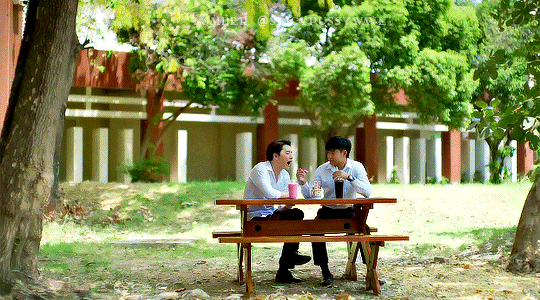
97 notes
·
View notes
Text
60 Years of the Tokaido Shinkansen!

On 1 October 1964, a railway line like no other opened. Connecting Tôkyô and Ôsaka, paralleling an existing main line, the Tôkaidô New Trunk Line had minimal curves, lots of bridges, zero level crossings. Striking white and blue electric multiple units, with noses shaped like bullets some would say, started zooming between the two cities as at the unheard-of speed of 210 km/h.
This was the start of the Shinkansen, inaugurating the age of high-speed rail.
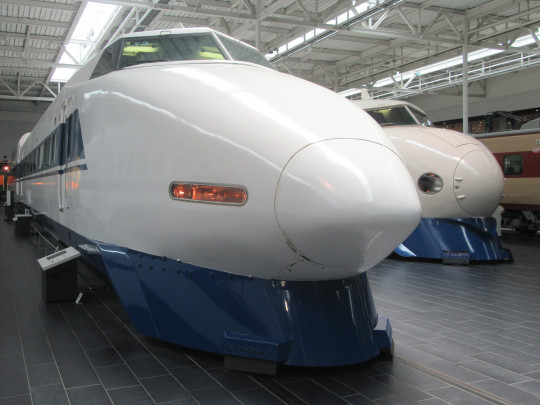
The trains, with noses actually inspired by the aircraft of the time, originally didn't have a name, they were just "Shinkansen trains", as they couldn't mingle with other types anyway due to the difference in gauge between the Shinkansen (standard gauge, 1435 mm between rails) and the rest of the network (3'6" gauge, or 1067 mm between rails). The class would officially become the "0 Series" when new trains appeared in the 1980s, first the very similar 200 Series for the second new line, the Tôhoku Shinkansen, then the jet-age 100 Series. Yes, the 200 came first, as it was decided that trains heading North-East from Tôkyô would be given even first numbers, and trains heading West would have odd first numbers (0 is even, but never mind).

Hence the next new type to appear on the Tôkaidô Shinkansen was the 300 Series (second from left), designed by the privatised JR Tôkai to overcome some shortcomings of the line. Indeed, the curves on the Tôkaidô were still too pronounced to allow speeds to be increased, while all other new lines had been built ready for 300 km/h operations. But a revolution in train design allowed speeds to be raised from 220 km/h in the 80s to 285 km/h today, with lightweight construction (on the 300), active suspension (introduced on the 700 Series, left) and slight tilting (standard on the current N700 types).

Examples of five generations of train used on the Tôkaidô Shinkansen are preserved at JR Tôkai's museum, the SCMaglev & Railway Park, in Nagoya, with the N700 prototype lead car outdoors. It's striking to see how far high-speed train technology has come in Japan in 60 years. The network itself covers the country almost end-to-end, with a nearly continuous line from Kyûshû to Hokkaidô along the Pacific coast (no through trains at Tôkyô), and four branch lines inland and to the North coast, one of which recently got extended.
東海道新幹線、お誕生日おめでおう!
#Japan#Shinkansen#Tokaido Shinkansen#0 Series#60th Anniversary#100 Series#300 Series#700 Series#JR Tokai#I'm posting this just after midnight Japanese time#oh well#late to the party#新幹線#東海道新幹線#0系#JR東海#Nagoya#SCMaglev & Railway Park#train#2023-07
98 notes
·
View notes
Note
I haven't heared the door knobs and fascism thing before, can you elaborate?
gladly! i was referencing one of the aphorisms by Theodor W. Adorno, Do Not Knock, one of my favourite philosophical texts, certainly top 5.
I would summarise it for you, but it's quite a short text and i am not embarrassing myself by trying to summarise Adorno, so I have transcribed it for you under the cut:
60. Do Not Knock
Technology is making gestures precise and brutal, and with them men. It expels from movements all hesitation, deliberation, civility. It subjects them to the implacable, as it were ahistorical demands of objects, Thus the ability is lost, for example, to close a door quietly and discreetly, yet firmly. Those of cars and refrigerators have to be slammed, others have the tendency to snap shut by themselves, imposing on those entering the bad manners of not looking behind them, not shielding the interior of the house which receives them. The new human type cannot be properly understood without awareness of what the is continuously exposed to from the world of things about him, even in his most secret innervations.
What does it mean for the subject that there are no more casements windows to open, but only sliding frames to shove, not gentle latches but turnable handles, no forecourt, no doorstep before the street, no wall around the garden? And which diver is not tempted, merely but the power of his engine, to wipe out the vermin of the street pedestrians, children and cyclists? The movements machines demand of their users already have the violent, hard-hitting, unresting jerkiness of Fascist maltreatment.
Not least to blame for the withering of experience is the fact that things, under the law of pure functionality, assume a form that limits contact with them to mere operation, and tolerates no surplus, either in freedom of conduct or in autonomy of things, which would survive as the core of experience, because it is not consumed by the moment of action.
#if you read it and think 'wow that's stupid' that's a normal reaction to adorno#if you read it and think 'my worldview has shifted forever' that's also a normal reaction to adorno#my friends and i used to joke that reading modern german philosophy#is just an endless cycle of strongly agreeing and strongly disagreeing with adorno.#if you had a strong reaction either way i would recommend you read more adorno and i would also strongly recommend you start with#'about jazz' because that's the true adorno perception stress test lmaoooo#anyways. if anyone wants to hear my top 5 influential german philosophers to quote in casual conversations for no reason i am ready
108 notes
·
View notes
Text
ARE WE ALONE IN THE UNIVERSE??
Blog#436
Saturday, September 14th, 2024.
Welcome back,
Are humans unique and alone in the vast universe? This question--summed up in the famous Drake equation--has for a half-century been one of the most intractable and uncertain in science.
But a new paper shows that the recent discoveries of exoplanets combined with a broader approach to the question makes it possible to assign a new empirically valid probability to whether any other advanced technological civilizations have ever existed.

And it shows that unless the odds of advanced life evolving on a habitable planet are astonishingly low, then human kind is not the universe’s first technological, or advanced, civilization.
The paper, published in Astrobiology, also shows for the first time just what “pessimism” or “optimism” mean when it comes to estimating the likelihood of advanced extraterrestrial life.
“The question of whether advanced civilizations exist elsewhere in the universe has always been vexed with three large uncertainties in the Drake equation,” said Adam Frank, professor of physics and astronomy at the University of Rochester and co-author of the paper.

“We’ve known for a long time approximately how many stars exist. We didn’t know how many of those stars had planets that could potentially harbor life, how often life might evolve and lead to intelligent beings, and how long any civilizations might last before becoming extinct.”
“Of course, we have no idea how likely it is that an intelligent technological species will evolve on a given habitable planet,” says Frank. But using our method we can tell exactly how low that probability would have to be for us to be the ONLY civilization the Universe has produced. We call that the pessimism line. If the actual probability is greater than the pessimism line, then a technological species and civilization has likely happened before.”

Using this approach, Frank and Sullivan calculate how unlikely advanced life must be if there has never been another example among the universe’s ten billion trillion stars, or even among our own Milky Way galaxy’s hundred billion.
The result? By applying the new exoplanet data to the universe’s 2 x 10 to the 22nd power stars, Frank and Sullivan find that human civilization is likely to be unique in the cosmos only if the odds of a civilization developing on a habitable planet are less than about one in 10 billion trillion, or one part in 10 to the 22nd power.

“One in 10 billion trillion is incredibly small,” says Frank. “To me, this implies that other intelligent, technology producing species very likely have evolved before us. Think of it this way. Before our result you’d be considered a pessimist if you imagined the probability of evolving a civilization on a habitable planet were, say, one in a trillion. But even that guess, one chance in a trillion, implies that what has happened here on Earth with humanity has in fact happened about a 10 billion other times over cosmic history!”

For smaller volumes the numbers are less extreme. For example, another technological species likely has evolved on a habitable planet in our own Milky Way galaxy if the odds against it evolving on any one habitable planet are better than one chance in 60 billion.
But if those numbers seem to give ammunition to the “optimists” about the existence of alien civilizations, Sullivan points out that the full Drake equation—which calculates the odds that other civilizations are around today—may give solace to the pessimists.

“Thanks to NASA's Kepler satellite and other searches, we now know that roughly one-fifth of stars have planets in “habitable zones,” where temperatures could support life as we know it. So one of the three big uncertainties has now been constrained.”
Frank said that the third big question--how long civilizations might survive--is still completely unknown. “The fact that humans have had rudimentary technology for roughly ten thousand years doesn’t really tell us if other societies would last that long or perhaps much longer,” he explained.

But Frank and his coauthor, Woodruff Sullivan of the astronomy department and astrobiology program at the University of Washington, found they could eliminate that term altogether by simply expanding the question.
“Rather than asking how many civilizations may exist now, we ask ‘Are we the only technological species that has ever arisen?" said Sullivan. “This shifted focus eliminates the uncertainty of the civilization lifetime question and allows us to address what we call the ‘cosmic archaeological question’—how often in the history of the universe has life evolved to an advanced state?”

That still leaves huge uncertainties in calculating the probability for advanced life to evolve on habitable planets. It's here that Frank and Sullivan flip the question around. Rather than guessing at the odds of advanced life developing, they calculate the odds against it occurring in order for humanity to be the only advanced civilization in the entire history of the observable universe. With that, Frank and Sullivan then calculated the line between a Universe where humanity has been the sole experiment in civilization and one where others have come before us.
Originally published on https://science.nasa.gov
COMING UP!!
(Wednesday, September 18th, 2024)
"IS IT POSSIBLE TO STOP TIME??"
#astronomy#outer space#alternate universe#astrophysics#universe#spacecraft#white universe#space#parallel universe#astrophotography
89 notes
·
View notes
Text
Scientists have developed a new solar-powered system to convert saltwater into fresh drinking water which they say could help reduce dangerous the risk of waterborne diseases like cholera.
Via tests in rural communities, they showed that the process is more than 20% cheaper than traditional methods and can be deployed in rural locations around the globe.
Building on existing processes that convert saline groundwater to freshwater, the researchers from King’s College London, in collaboration with MIT and the Helmholtz Institute for Renewable Energy Systems, created a new system that produced consistent levels of water using solar power, and reported it in a paper published recently in Nature Water.
It works through a process called electrodialysis which separates the salt using a set of specialized membranes that channel salt ions into a stream of brine, leaving the water fresh and drinkable. By flexibly adjusting the voltage and the rate at which salt water flowed through the system, the researchers developed a system that adjusts to variable sunshine while not compromising on the amount of fresh drinking water produced.
Using data first gathered in the village of Chelleru near Hyderabad in India, and then recreating these conditions of the village in New Mexico, the team successfully converted up to 10 cubic meters, or several bathtubs worth of fresh drinking water. This was enough for 3,000 people a day with the process continuing to run regardless of variable solar power caused by cloud coverage and rain.
[Note: Not sure what metric they're using to calculate daily water needs here. Presumably this is drinking water only.]
Dr. Wei He from the Department of Engineering at King’s College London believes the new technology could bring massive benefits to rural communities, not only increasing the supply of drinking water but also bringing health benefits.
“By offering a cheap, eco-friendly alternative that can be operated off the grid, our technology enables communities to tap into alternative water sources (such as deep aquifers or saline water) to address water scarcity and contamination in traditional water supplies,” said He.
“This technology can expand water sources available to communities beyond traditional ones and by providing water from uncontaminated saline sources, may help combat water scarcity or unexpected emergencies when conventional water supplies are disrupted, for example like the recent cholera outbreaks in Zambia.”
In the global rural population, 1.6 billion people face water scarcity, many of whom are reliant on stressed reserves of groundwater lying beneath the Earth’s surface.
However, worldwide 56% of groundwater is saline and unsuitable for consumption. This issue is particularly prevalent in India, where 60% of the land harbors undrinkable saline water. Consequently, there is a pressing need for efficient desalination methods to create fresh drinking water cheaply, and at scale.
Traditional desalination technology has relied either on costly batteries in off-grid systems or a grid system to supply the energy necessary to remove salt from the water. In developing countries’ rural areas, however, grid infrastructure can be unreliable and is largely reliant on fossil fuels...
“By removing the need for a grid system entirely and cutting reliance on battery tech by 92%, our system can provide reliable access to safe drinking water, entirely emission-free, onsite, and at a discount of roughly 22% to the people who need it compared to traditional methods,” He said.
The system also has the potential to be used outside of developing areas, particularly in agriculture where climate change is leading to unstable reserves of fresh water for irrigation.
The team plans to scale up the availability of the technology across India through collaboration with local partners. Beyond this, a team from MIT also plans to create a start-up to commercialize and fund the technology.
“While the US and UK have more stable, diversified grids than most countries, they still rely on fossil fuels. By removing fossil fuels from the equation for energy-hungry sectors like agriculture, we can help accelerate the transition to Net Zero,” He said.
-via Good News Network, April 2, 2024
#water#water scarcity#clean water#saline#desalination#off grid#battery technology#solar power#solar energy#fossil fuels#water shortage#india#hyderabad#new mexico#united states#uk#united kingdom#good news#hope#aquifers
999 notes
·
View notes
Text
The “Green Revolution” is the name given to a wholescale transformation of global food production led primarily by the United States that began in the 1940s and accelerated from the ’60s through the ’80s. It used collaborative research, public subsidies, chemical fertilizers, and genetic modifications to increase global food production, but it also led to greater carbon emissions from agriculture, soil erosion, increased diffusion of toxic chemicals, and other environmental degradations. There were also profoundly negative social consequences, as large agricultural production was emphasized without any accompanying focus on inequalities in land distribution or gendered labor. Overall food instability as a result in fact increased in countries where the Green Revolution took place, even as it decreased globally. How did that happen? The food writer and historian Mark Bittman notes that the massive decrease in global hunger in these years happened almost exclusively in China, where there was no Green Revolution. Instead, Chinese leaders focused on state support for independent farmers, and the goal was to reduce poverty, not just increase crop yields. Having more crops available does not mean they will be properly distributed, after all. Much of the world’s explosion of new corn products during the Green Revolution in other countries, for example, went to ethanol and high-fructose corn syrup. China’s more direct if still imperfect approach achieved more of what the Green Revolution promised: “Production tripled post-Mao, but, more important, the world’s most dramatic decrease in poverty ever took place.” That didn’t happen because of technological change alone, but because of the combination of technology, investment in ordinary people, and economic regulation.
Avram Alpert, The Good-Enough Life
63 notes
·
View notes
Text
A notable diversity among the artisans was identified, as men, women, and children actively participated in making figurines, challenging the preconceived notion that this was an exclusively male craft." In other words archaeologists were stunned that women also worked in the family businesses and children were trained in the family business while still young. 🤦♀️
by Guillermo CarvajalJanuary 14, 2025

Example of a figurine (H20257) from Thonis-Heracleion with close-up of the fingerprints found on the reverse and interior. Credit: Franck Goddio / Hilti Foundation
An archaeological study published in the Oxford Journal of Archaeology by Leonie Hoff analyzes the fingerprints impressed on terracotta figurines found in the ancient city of Thonis-Heracleion in Egypt (located near Alexandria, with its ruins discovered 2.5 kilometers offshore and 10 meters underwater).
This analysis, which combines advanced technology with traditional archaeological methods, reveals who the artisans were that molded these pieces between the 7th and 2nd centuries BCE, offering unprecedented details about the organization of labor in ancient Egypt.
Thonis-Heracleion, a thriving Egyptian port located near the Nile’s mouth, flourished as a vital hub for trade and control between the Greek and Egyptian worlds. The city, founded in the 8th century BCE, became a cultural and economic center until its prominence was overshadowed by Alexandria. A natural disaster in the 2nd century BCE caused its collapse, and it remained hidden underwater until its rediscovery in the 1990s.

Map of the known sanctuaries and major finds at Thonis-Heracleion. Credit: Franck Goddio / IEASM
In this context, the terracotta figurines found at the site provide crucial clues about daily practices, cultural interactions, and the division of labor in a cosmopolitan community.
The study focuses on nine figurines selected from over 60 that show visible fingerprints. These impressions were analyzed using Reflectance Transformation Imaging (RTI), a method that measures the density and amplitude of epidermal ridge patterns in the fingerprints. These data, cross-referenced with modern studies of fingerprint density, enabled the estimation of the artisans’ sex and age.
The study highlights three key findings that redefine our understanding of artisanal production in ancient Thonis-Heracleion. First, a notable diversity among the artisans was identified, as men, women, and children actively participated in making figurines, challenging the preconceived notion that this was an exclusively male craft.

Silicone moulded copy of imprints found on the interior of H20257, including measurements taken for ridge breadths (lines) and ridge densities (squares). Credit: Franck Goddio / Hilti Foundation
Moreover, the fingerprints reveal a collaborative process in which children, likely apprentices, worked under the supervision of adults, pointing to the existence of a structured training system within the workshops. Lastly, a significant cultural impact was observed, evidenced by the adoption of Greek techniques, such as using molds and fine materials, which were integrated with local styles and characteristics to create unique products reflecting the fusion of both cultures.
The presence of children in the workshops suggests a family-based artisanal economy, while the inclusion of women indicates a more equitable division of labor than previously assumed.
Differences between imported and locally produced figurines reflect dynamic cultural interactions. Greek objects tend to be more sophisticated and associated with predominantly male labor, while local pieces show greater diversity in participation.
This pioneering study in the use of fingerprints to understand Mediterranean archaeology lays the groundwork for broader research. Fingerprint analysis at other sites could reveal similar patterns and deepen our understanding of artisanal work and social relations in the ancient world.
SOURCES
Hoff, L. (2024) Fingerprints on figurines from Thonis-Heracleion. Oxford Journal of Archaeology, 43: 399–418. doi.org/10.1111/ojoa.12308
#Oxford Journal of Archaeology#Leonie Hoff#ancient city of Thonis-Heracleion#Egypt#Reflectance Transformation Imaging (RTI)#Women have always worked
48 notes
·
View notes